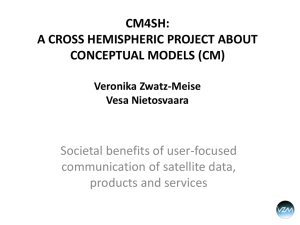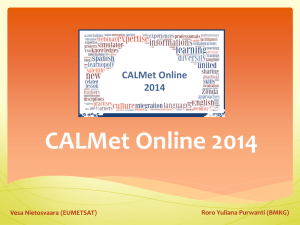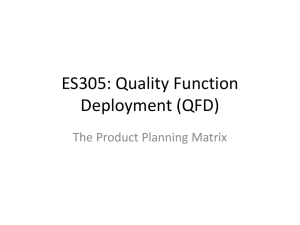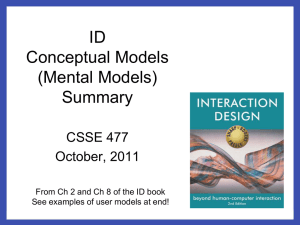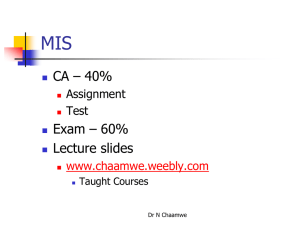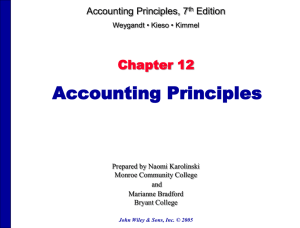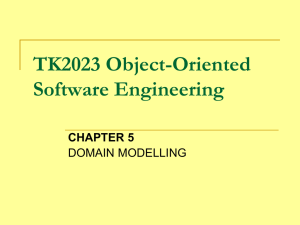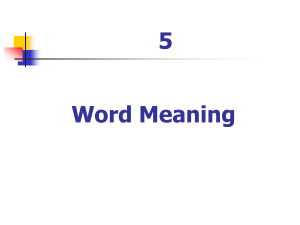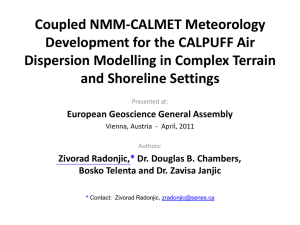Document
advertisement
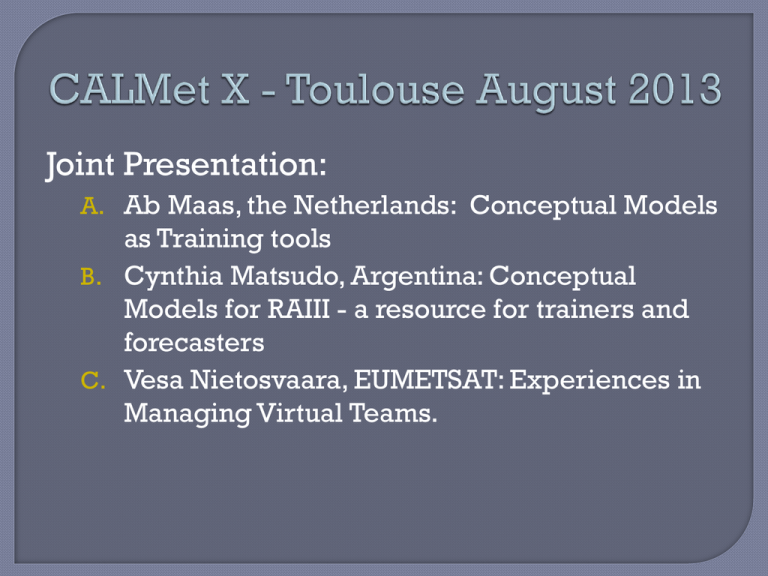
Joint Presentation: A. Ab Maas, the Netherlands: Conceptual Models as Training tools B. Cynthia Matsudo, Argentina: Conceptual Models for RAIII - a resource for trainers and forecasters C. Vesa Nietosvaara, EUMETSAT: Experiences in Managing Virtual Teams. Conceptual Models as Training tools Worldwide Online development of training material Project Conceptual Models for Southern Hemisphere CM4SH In cooperation with: Conceptual Model Conceptual Models in Satellite Meteorology Project from 1995 – 2005 Collaboration of several European Met. Institutes with support of Eumetsat End Result: MANUAL OF SYNOPTIC SATELLITE METEOROLOGY (SatManu) 50 conceptual models described The Manual is designed to be used by: 1. University students with a basic knowledge of synoptic meteorology and satellite meteorology 2. Meteorologists and forecasters The manual is maintained and modernized within Eumetrain Not only Europe Satmanu has proved its value as a training- and a forecasting tool throughout Europe and outside. The idea of using conceptual models in satellite meteorology is of course not only a European thought there is an interest all over the world. The idea to widen the CM thinking to other parts of the globe and to develop Conceptual Models more appropriate for other regions was made more concrete during courses is South Africa in 2010 Eumetsat course in Pretoria and the CalMet conference also in Pretoria. More WMO Vlabs were interested. After initiatives from Eumetsat (Volker Gaertner) and the “hard core” of Satmanu developers ( Veronika Zwatz-Meise, etc.) The project started in January this year and will end in March 2014 with a possibility of extension. The purpose and objectives of the project The purpose of the project is to improve warnings and awareness of weather risks through the use of conceptual models. . The Objectives of the project are to produce and make available resources about Conceptual Models for the CoE areas of interest. To make these resources also available for other training institutions within region. To increase the operational forecasters’ understanding of the weather systems with the help of Conceptual Models. The outcomes, deliverables and the benefits expected Outcome and deliverables A comprehensive list of CMs in the areas of interest of all participating VLabs/CoEs with already existing literature A quick-look collection of interesting CM cases from archive and actual cases with quick-look descriptions Some fully developed representative examples (which and how many TBD) preferable in a SH-SatManu version Cross connection among material (different styles already existing) Expected Benefits Optimal training material for VLabs/CoEs and other training institutions Basis for integration in application methods in weather services (Nowcasting and warnings) Spread Participating countries: Australia (BOM) Argentina Brazil South Africa European Expert Team: Veronika Zwatz-Meise Henk Verschuur Ab Maas Vesa Nietosvaara Reviewers: Bernadette Connell, CIRA, CO, USA Michael Davison, NOAA, USA Structure Coordinating the project: Vesa Coordinator of the expert team: Veronika Tasks of the expert team: Organizing the project work Training sessions Guarding the uniformity of the deliverables Online meetings exclusively Literature Survey Choice of case studies or Conceptual Models Online Training sessions: Fronts Over to Cynthia Cyclogenesis Jets and Frontal structures Convective systems Local phenomena Finding good cases and developing CS or CM’s Conceptual Models for RAIII a resource for trainers and forecasters CM4SH - Conceptual Models for Southern Hemisphere Project Argentina VLab Centre of Excellence Joint CALMet X and Eumetcal Workshop – 26-30 August 2013 – Toulouse, France Inspired by the European Manual MANUAL OF SYNOPTIC SATELLITE METEOROLOGY (SatManu) developed by Veronika Zwatz-Meise, Henk Verschuur, Ab Maas,Vesa Nietosvaara CM4SH Project CoE Argentina in cooperation with WMO and Eumetsat Our team: NMS Argentina In cooperation with: DCAO-UBA Department of Atmospheric and Oceanic Sciences- University of Buenos Aires CONAE – National Commission for Spatial Activities NOAA-NESDIS Joint CALMet X and Eumetcal Workshop – 26-30 August 2013 – Toulouse, France Our main goals: Working towards a SatManu for the region in Spanish version To make this new resource available for the local forecasters and the regional community Learning process Opportunity to: Start to develop training material in Spanish knowledge transfer from documented studies to forecasting tools Be assisted by the European experts benefit from their background First inspection of the actual training needs of forecasters Reinforce interaction between institutions (university) and other countries (Brazil, Chile) Promote the activities of CoE Argentina for the region Joint CALMet X and Eumetcal Workshop – 26-30 August 2013 – Toulouse, France We proposed to develop 2 full CMs: 1) SALLJ associated to MCSs 2) Zonda-Puelche Interaction with University, Brazil Interaction with Chile reinforced Why these events? Impact: severe weather Joint CALMet X and Eumetcal Workshop – 26-30 August 2013 – Toulouse, France SALLJ: South American Low Level Jet Frequency of convection (IR brightness < 218K) for MCS-SALLJ days MCS – 2008/21/10 NOAA-AVHRR RGB124@18Z Salio et al, MWR, 2007 Joint CALMet X and Eumetcal Workshop – 26-30 August 2013 – Toulouse, France Zonda (NW Argentina) – Puelche (Southern Chile) GOES WV Channel Buenos Aires MCS red: T, blue: dew point, black: surface pressure Joint CALMet X and Eumetcal Workshop – 26-30 August 2013 – Toulouse, France Steps involved in developing this project: Milestone 1: Nomination of teams Milestone 2: Orientation training sessions Milestone 3: Literature survey and CMs selection Milestone 4: Training phase Milestone 5: Quicklook collection Present stage Milestone 6: Detailed development of selected CMs Milestone 7: Scientific Review phase Joint CALMet X and Eumetcal Workshop – 26-30 August 2013 – Toulouse, France Quicklook example 2002/12/19 Reasons for selecting this case: 1. MCS associated with the SALLJ event was one of the biggest during the warm season of 20022003. 2. High values of accumulated rainfall over central-east of Argentina. Additional information: • Squall line. • Initiation: • Potencial Convective Instability • CVA at mid levels. • Discontinuity of water vapor at low levels. • Convergence at the exit region of the LLJ. Joint CALMet X and Eumetcal Workshop – 26-30 August 2013 – Toulouse, France This initiative have already had some spin-offs: More interaction between different departements within the NMS and with the University Chance to explore new key parameters/variables (such Termal front parameter) which better describe our regional events It revealed gaps of information to develop other CMs – regional scientific studies to match the SatManu contents are needed Points out the need of skill and technical support for the implementation of the e-learning training We need support to form trainers Joint CALMet X and Eumetcal Workshop – 26-30 August 2013 – Toulouse, France Experiences in Managing Virtual Teams Vesa Nietosvaara Virtual team Conceptual Models for SH: ~ 30 people, 5 continents, 2 hemispheres Slid Virtual team Conceptual Models for SH: ~ 30 people, 5 continents, 2 hemispheres For one minute imagine you are managing this project. Slid Virtual team Conceptual Models for SH: ~ 30 people, 5 continents, 2 hemispheres For one minute imagine you are managing this project. As a Project Manager, what worries you the most? Slid Virtual team Conceptual Models for SH: ~ 30 people, 5 continents, 2 hemispheres For one minute imagine you are a Team Member in this project. Slid Virtual team Conceptual Models for SH: ~ 30 people, 5 continents, 2 hemispheres For one minute imagine you are a Team Member in this project. As a Team Member, what is you biggest expectation from Project Manager? Slid Things I worry about: DEADLINES MILESTONES TASKS MINUTES DELIVERABLES BUDGETS ONLINE TECHNOLOGY Slid Things I should worry about: ENGAGEMENT INSPIRATION PRESENCE TRUST ENCOURAGEMENT MOTIVATION Slid DEVELOPING TRUST (After Fisher: “The Distance Manager”) Communicate openly and frequently. To get trust, give trust. Be honest. Interact in consistent and predictable way. Watch your opening words. Be accessible and responsive. Maintain confidences. Use language that everyone can understand. Do what you say you will do. Slid SUMMARY: The Content Objectives of Virtual Team CM4SH To collect, create and share resources about CMs for Southern Hemisphere. To increase the operational forecasters’ understanding of the weather systems with the help of CMs. Baroclinic leaf Comma cloud Vortex deformation cloud Buenos Aires MCS Slid SUMMARY: The Process Objectives of Virtual Team CM4SH To establish a virtual team that can work together and support each other despite the distance, team members trusting and inspiring each other. Baroclinic leaf Comma cloud Vortex deformation cloud Buenos Aires MCS Slid
